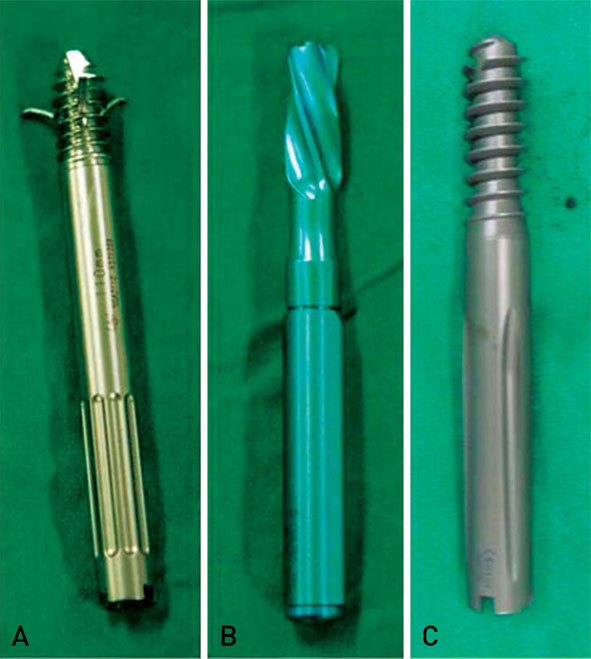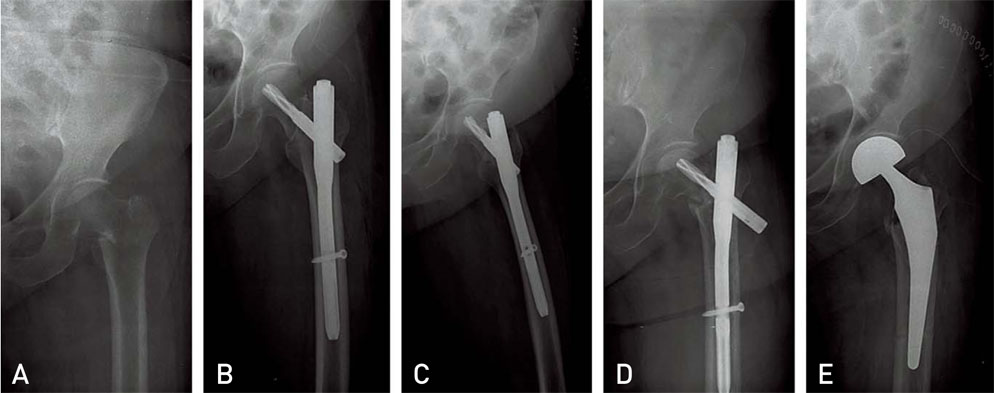Hip Pelvis.
2013 Sep;25(3):211-219. 10.5371/hp.2013.25.3.211.
Comparison of the Dyna Locking Trochanteric Nail, Proximal Femoral Nail Antirotation and Gamma 3 Nail in Treatment of Intertrochanteric Fracture of the Femur
- Affiliations
-
- 1Department of Orthopaedic Surgery, College of Medicine, Dong-A University, Busan, Korea. hyeonjun@dau.ac.kr
- KMID: 1974377
- DOI: http://doi.org/10.5371/hp.2013.25.3.211
Abstract
- PURPOSE
The purpose of this study is to compare and analyze the radiological and clinical results after treatment of intertrochanteric fractures of the femur by three devices including DLT, PFNA and Gamma 3 nail.
MATERIALS AND METHODS
From January 2007 to January 2012, we reviewed 131 patients who suffered intertrochanteric fractures(33 cases of DLT, 59 cases of PFNA, 39 cases of Gamma 3 nail). The following were measured for all three groups; The tip apex distance (TAD), neck shaft angle and lag screw position at the head of femur, as well as the amount of blood loss and transfusion, operation time, duration of hospitalization and postoperative ICU admission, complications were also assessed.
RESULTS
In comparison of the radiological results, there were no statistical differences among the three groups in TAD, neck shaft angle and the lag screw position. There was no statistical difference in clinical results. In the last follow-up, there was one case of nonunion in the PFNA group. There also was, in the last follow up, a development of varus angulation & cut-out of lag screw that occurred in 2 cases (DLT), 4 cases (PFNA), 1 cases (Gamma 3). There was no statistical difference among the three groups in the sliding length of the lag screw.
CONCLUSION
Any certain group was not better than the others with regard to the radiological and clinical results among DLT, PFNA and Gamma nail groups in treating intertrochanteric fracture. To achieve favorable results, precise reduction of fracture site and surgical techniques are important.
Keyword
Figure
Cited by 3 articles
-
Treatment of Intertrochanteric Fractures Using the Compression Hip Nail
Je-Min Yi, Kye Young Han, Keun Woo Kim, Chang Hyun Ryu
Hip Pelvis. 2014;26(3):166-172. doi: 10.5371/hp.2014.26.3.166.Intrapelvic Migration of the Lag Screw with Wedge Wing from Dyna Locking Trochanteric Nail: A Case Report and Literature Review
Yong-Woo Kim, Weon-Yoo Kim, Kyong-Jun Kim, Se-Won Lee
Hip Pelvis. 2019;31(2):110-119. doi: 10.5371/hp.2019.31.2.110.Clinical Outcomes of U-blade Gamma3 Nails Used to Treat Patients with Trochanteric Fractures: Retrospective Multicenter Study
Jehyun Yoo, Sangmin Kim, Hojung Jung, Jihyo Hwang
Hip Pelvis. 2019;31(2):95-101. doi: 10.5371/hp.2019.31.2.95.
Reference
-
1. Kim DS, Shon HC, Kim YM, Choi ES, Park KJ, Im SH. Postoperative mortality and the associated factors for senile hip fracture patients. J Korean Orthop Assoc. 2008; 43:488–494.
Article2. Richmaond J, Aharonoff GB, Zuckerman JD, Koval KJ. Mortality risk after hip fracture. 2003. J Orthop Trauma. 2003; 17:S2–S5.3. Kyle RF, Cabanela ME, Russell TA, et al. Fractures of the proximal part of the femur. Instr Course Lect. 1995; 44:227–253.
Article4. Suh JT, Yoo CI, Chung WB. A clinical study of trochanteric fractures of the femur in the elderly over 70 years in the age. J Korean Soc Fract. 1994; 7:293–301.
Article5. Halder SC. The Gamma nail for peritrochanteric fractures. J Bone Joint Surg Br. 1992; 74:340–344.
Article6. Hardy DC, Descamps PY, Krallis P, et al. Use of an intramedullary hip-screw compared with a compression hip-screw with a plate for intertrochanteric femoral fractures. A prospective, randomized study of one hundred patients. J Bone Joint Surg Am. 1998; 80:618–630.
Article7. Lee KJ, Min BW, Kim SG, Song KS, Bae KC, Cho CH. Results of treating senile osteoporotic peritrochanteric fracture with proximal femoral nail antirotation (PFNA). J Korean Hip Soc. 2009; 21:162–168.
Article8. Gotfried Y. The lateral trochanteric wall: a key element in the reconstruction of unstable pertrochanteric hip fractures. Clin Orthop Relat Res. 2004; (425):82–86.9. Adams CI, Robinson CM, Courl-Brown CM, McQueen MM. Prospective randomized controlled trial of an intramedullary nail versus dynamic screw and plate for intertrochanteric fractures of the femur. J Orthop Trauma. 2001; 15:394–400.
Article10. Pajarinen J, Lindahl J, Michelsson O, Savolainen V, Hirvensalo E. Pertrochanteric femoral fractures treated with a dynamic hip screw or a proximal femoral nail. A randomised study comparing post-operative rehabilitation. J Bone Joint Surg Br. 2005; 87:76–81.11. Baumgaertner MR, Curtin SL, Lindskog DM, Keggi JM. The value of the tip-apex distance in predicting failure of fixation of peritrochanteric fractures of the hip. J Bone Joint Surg Am. 1995; 77:1058–1064.
Article12. Cleveland M, Bosworth DM, Thompson FR, Wilson HJ Jr, Ishizuka T. A ten-year analysis of intertrochanteric fractures of the femur. J Bone Joint Surg Am. 1959; 41-A:1399–1408.
Article13. Kim YS, Yoon JW, Han SK. Treatment of intertrochanteric fracture of the femur using a dyna locking trochanteric nail. J Korean Hip Soc. 2010; 22:216–221.
Article14. Chung YK, Hwang JH, Kim HK. The treatment of peritrochanteric fracture of femur with proximal femoral nail:comparative study with dynamic hip screw. J Korean Hip Soc. 2007; 19:167–175.
Article15. Strauss E, Frank J, Lee J, Kummer FJ, Tejwani N. Helical blade versus sliding hip screw for treatment of unstable intertrochanteric hip fractures: a biomechanical evaluation. Injury. 2006; 37:984–989.
Article16. Oh JK, Hwang JH. Osteoporotic pertrochanteric fracture: IM nailing. J Korean Fract Soc. 2009; 22:56–65.
Article17. Sommers MB, Roth C, Hall H, et al. A laboratory model to evaluate cutout resistance of implants for pertrochanteric fracture fixation. J Orthop Trauma. 2004; 18:361–368.
Article18. Lee JY, Lee SY. Treatment of the proximal femoral extracapsular fracture with proximal femoral nail antirotation (PFNA): comparision with proximal femoral nail (PFN). J Korean Hip Soc. 2007; 19:183–189.
Article19. Varela-Egocheaga JR, Iglesias-Colao R, Suárez-Suárez MA, Fernández-Villán M, González-Sastre V, Murcia-Mazón A. Minimally invasive osteosynthesis in stable trochanteric fractures: a comparative study between Gotfried percutaneous compression plate and Gamma 3 intramedullary nail. Arch Orthop Trauma Surg. 2009; 129:1401–1407.
Article20. Yaozeng X, Dechun G, Huilin Y, Guangming Z, Xianbin W. Comparative study of trochanteric fracture treated with the proximal femoral nail anti-rotation and the third generation of gamma nail. Injury. 2010; 41:1234–1238.
Article21. Hsueh KK, Fang CK, Chen CM, Su YP, Wu HF, Chiu FY. Risk factors in cutout of sliding hip screw in intertrochanteric fractures: an evaluation of 937 patients. Int Orthop. 2010; 34:1273–1276.
Article22. Geller JA, Saifi C, Morrison TA, Macaulay W. Tip-apex distance of intramedullary devices as a predictor of cut-out failure in the treatment of peritrochanteric elderly hip fractures. Int Orthop. 2010; 34:719–722.
Article23. Pervez H, Parker MJ, Vowler S. Prediction of fixation failure after sliding hip screw fixation. Injury. 2004; 35:994–998.
Article24. Parker MJ. Cutting-out of the dynamic hip screw related to its position. J Bone Joint Surg Br. 1992; 74:625.
Article25. Davis TR, Sher JL, Checketts RG, Porter BB. Intertrochanteric fractures of the femur: a prospective study comparing the use of the Küntscher-Y nail and a sliding hip screw. Injury. 1988; 19:421–426.
Article26. Gundle R, Gargan MF, Simpson AH. How to minimize failures of fixation of unstable intertrochanteric fractures. Injury. 1995; 26:611–614.
Article27. De Bruijn K, den Hartog D, Tuinebreijer W, Roukema G. Reliability of predictors for screw cutout in intertrochanteric hip fractures. J Bone Joint Surg Am. 2012; 94:1266–1272.
Article28. Kyle RF, Gustilo RB, Premer RF. Analysis of six hundred and twenty-two intertrochanteric hip fractures. J Bone Joint Surg Am. 1979; 61:216–221.
Article
- Full Text Links
- Actions
-
Cited
- CITED
-
- Close
- Share
- Similar articles
-
- Treatment of Femoral Intertrochanteric Fracture with Proximal Femoral Nail
- Treatment of Intertrochanteric Fracture of Femur: A Randomized Prospective Comparative Analysis of the Internal Fixation of Gamma Nail and Compression Hip Screw
- Treatment of Intertrochanteric Fracture of the Femur Using a Dyna Locking Trochanteric (DLT) Nail
- Comparative Study of Intertrochanteric Fracture Treated with the Proximal Femoral Nail Anti-Rotation and the Third Generation of Gamma Nail
- Pseudoaneurysm of the Superficial Femoral Artery Following Gamma nail Fixation for Trochanteric Fracture: A Case Report



